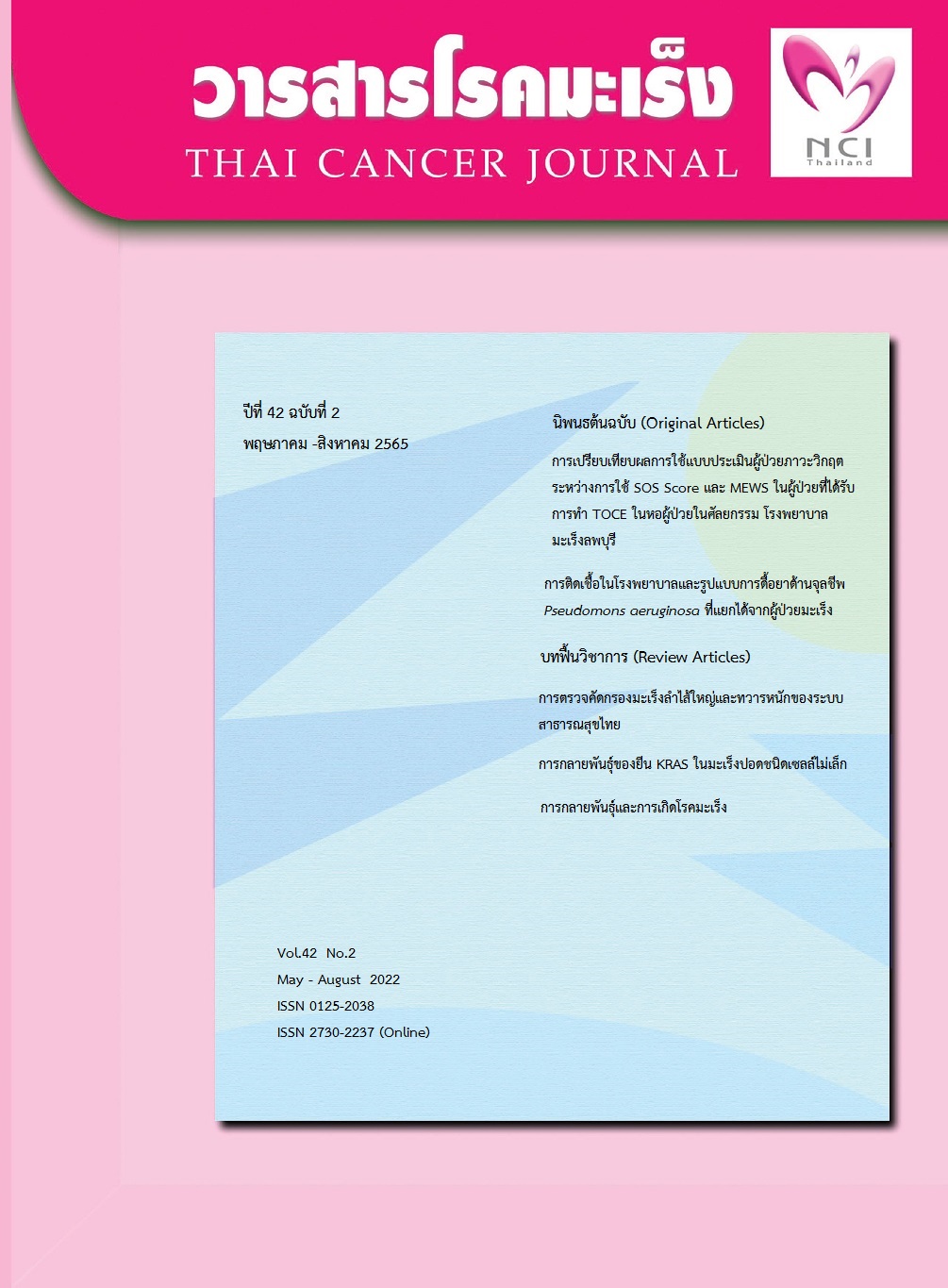Nosocomial Infection and Drug Resistant Patterns of Pseudomons aeruginosa Isolated from Cancer Patients
Keywords:
โรคติดเชื้อในโรงพยาบาล, เชื้อ P. aeruginosa, รูปแบบการดื้อต่อยาต้านจุลชีพAbstract
Cancer patients are particularly susceptible to nosocomial infections because of their compromised immune systems. Pseudomonas aeruginosa is one of the most common Gram negative bacterium found in nosocomial and community acquired infections. This study were analyzed the distribution and antimicrobial resistant patterns of nosocomial infection isolated from cancer patients admitted to the National Cancer Institute (NCI), Thailand. The 28 of P. aeruginosa were isolated from clinical samples, which were collected from cancer patients who admit in NCI. All isolates were identified by conventional biochemical tests. Antimicrobial susceptibility of all the isolate was performed by according to the Clinical and Laboratory Standards Institute (CLSI) guidelines. A total of 28 non-susceptible P. aeruginosa were collected from clinical specimens of cancer patients. The Patients were consisted of 57.1% (n=16) males and 42.9% (n=54) females, and the ages of the patients were ranged from 26 to 80 years old. The results were showed that Non-ICU was most place of infection 71.5% (n=20), ICU and OPD were founded 21.4% (n=6) and 7.1% (n=2) respectively. Hepatocellular carcinoma and cholangiocarcinoma patients were most cancer type, which was infected by P. aeruginosa 25.9% (n=7) and respiratory tract system was major route of P. aeruginosa infection 46.5% (n=13). Almost all of the isolates were showed a MDR phenotype to ciprofloxacin (CIP), levofloxacin (LFX), imipenem (IMP) and meropenem (MEM) mostly to carbapenems (78.6-92.9%), these resistant strains showed high level of resistance to IMP and MEM, however, all of them were susceptible to collistin (CO) and polymixin B (PB) by 100%. This study demonstrated the nosocomial infection and antimicrobial resistant properties from P. aeruginosa in cancer patient trend to increase and high drug resistant rate. Thus, prevention of nosocomial infection caused by clinical practice and informs the choice of the most appropriate antibiotics for the treatment and prophylaxis of cancer patients.
References
Rashid A, Chowdhury A, Rahman HZ S, Begum Ara S, Muazzam N. Infections by Pseudomonas aeruginosa and Antibiotic Resistance Pattern of the Isolates from Dhaka Medical College Hospital. Bangladesh J Med Microbiol 2007;1(2):48-51.
Estahbanati HK, Kashani PP, Ghanaatpishels F. Frequency of Pseudomonas aerugunosa serotypes in burn wound infections and their resistance to antibiotics. Burns 2002;28: 340-8.
Netsvyetayeva, I., Sikora, M., Golas, M., Swoboda-Kopec, E., de Walthoffen, SW.,
Dembicka. O.,et al. Acinetobacter baumannii multidrug-resistant strain occurrence in liver recipients with reference to other high-risk groups. Transplant Proc 2011;43(8):3116-20.
พิชชาพร อธิกวิริยะกุล, ญาณภา มณีศรี,รุจิฬา ปิงยศ. Treatment of Multidrug-resistant Acinetobacter baumannii in Thailand. บทความเผยแพร่เพื่อให้ความรู้แก่บุคลากรทางการแพทย์ 2552.เข้าถึงเมื่อ 14 มีนาคม 2565.เข้าถึงได้จาก: https://www.ninerx.com/smf/index.php/topic
,2117. Msg10492. html# msg10492.
Clinical and Laboratory Standards Institute (CLSI). Performance standard for antimicrobial disk susceptibility testing: 19th information supplements (M02-A10 and M07-A8). Wayne, PA: CLSI 2009.
สมหวัง ด่านชัยวิจิตร, บรรณาธิการ. โรคติดเชื้อในโรงพยาบาล. พิมพ์ครั้งที่3. กรุงเทพฯ: แอล ทีเพรส;2544:1-16.
Thompat W, Sudjaroen Y. Characterization and antibiotic susceptibility profile of nosocomial pathogens isolated from cancer patients. Thai Can J 2009;29(4):176-83
Pagani L, Colinon C, Migliavacca R, Labonia M, DocquierJD, Nucleo E, et al. Nosocomial Outbreak Caused by Multidrug-Resistant Pseudomonas aeruginosa Producing IMP-13 Metallo- ß –Lactamase. J Clin Microbiol 2005;43(8):3824-28.
Ergin, C., & Mutlu, G. (1999). Clinical distribution and antibiotic resistance of Pseudomonas species. Eastern J Med;4(2):65-9.
ศูนย์เฝ้าระวังเชื้อดื้อยาแห่งชาติ กรมวิทยาศาสตร์การแพทย์ กระทรวงสาธารณสุข (National Antimicrobial Resistant Surveillance Center Thailand; NARST). Available at :http://www.dmsc.moph.go.th. Accessed November 28, 2010
Dejsirilert S, Suankratay C, Trakulsomboon S, Thongmali O, Sawanpanyalert P, Aswapokee N. National Antimicrobial Resistance Surveillance, Thailand (NARST) Data among Clinical Isolates of Pseudomonas aeruginosa in Thailand from 2000 to 2005. J Med Assoc Thai 2009; 4:S68-75 .
วิษณุ ธรรมลิขิตกุล. โคลิสติน: ยาต้านจุลชีพสำหรับรักษา โรคติดเชื้อแบคทีเรียกรัมลบดื้อยา. เวชบันทึก ศิริราช2551;1(3):151-8.
ศูนย์เฝ้าระวังเชื้อดื้อยาแห่งชาติ กรมวิทยาศาสตร์การแพทย์ กระทรวงสาธารณสุข.เข้าถึงเมื่อ 28 พฤศจิกายน 2565.เข้าถึงได้จากhttp://www.dmsc.moph.go.th.
Downloads
Published
Issue
Section
License
Copyright (c) 2022 Thailand's National Cancer Institute Foundation

This work is licensed under a Creative Commons Attribution-NonCommercial-NoDerivatives 4.0 International License.
บทความทีตีพิมพ์ในวารสารโรคมะเร็งนี้ถือว่าเป็นลิขสิทธิ์ของมูลนิธิสถาบันมะเร็งแห่งชาติ และผลงานวิชาการหรือวิจัยของคณะผู้เขียน ไม่ใช่ความคิดเห็นของบรรณาธิการหรือผู้จัดทํา






